|
COVER STORY | IN
THE NEWS | STAGE
MATTERS | DIRT April 27, 2006
story and photos by HANK SIMS Frank Jager, Humboldt County's coroner, is about the only law enforcement official speaking about the death of Cheri Lyn Moore, and even he isn't saying much. Most of the information he has released from Moore's autopsy is something anyone in the county could have guessed, pretty much: On Friday, April 14, in the early afternoon, Moore, a 48-year-old woman, was killed by multiple gunshot wounds to the upper half of her body. For the last two weeks, people have had to piece together the rest of the story from scraps --from people who knew Moore, from witnesses to the shooting, from the intense media coverage that has followed her death and from the scant information provided by the Eureka Police Department, whose officers fired the shots that killed her. Just before 10 a.m. that day, the EPD received a call from the county's Mental Health Department, asking them to check up on Moore. The Mental Health employee told the police that she would be hostile. Officers went to her apartment above Heuer's Florist, on the corner of Fifth and G streets in downtown Eureka. They heard loud music and yelling in the apartment, but no one would open the door. Finally, the landlord let them in, at which point Moore drew a weapon on them. They retreated. This information comes from an EPD press release issued the next day. After the officers left the apartment, a standoff ensued. The department brought in more policemen and blocked off the streets. According to EPD records obtained by the Eureka Reporter, they determined that Moore's weapon was a flare gun. They placed an officer armed with a sniper rifle on a building across the street. Moore called the Mental Health Department, requesting medication. She also called friends. Witnesses outside later stated that Moore threw things from her second-story window down to the sidewalk and blasted music from the apartment. She poked her head out occasionally, yelling down to the scene outside her window. The EPD incident logs, as printed in the Reporter, stated that she held the flare gun to her chest and threatened to fire. The EPD's armed SWAT team entered the building shortly after noon. Someone made the decision that they would enter the apartment if Moore could be seen at the window without the weapon. Just after 12:30, the officer on the roof opposite reported that she was now there, at the window unarmed. The SWAT team entered the apartment -- it is believed that they broke the door in -- and found that Moore had the flare gun in hand. They opened fire. These are the bare facts. They have not been sufficient. In the weeks since, the story has grown larger and larger, with more and more people expressing discomfort or shock over what transpired in those two and a half hours, yet very little has been added to the who, what, when, where, why and how of what happened. The Eureka Police Department has said that it is awaiting the results of an interagency investigation into the incident, conducted by law enforcement officers from around the county, before speaking on the subject. By late Tuesday, at the time the Journal went to press, the investigation had not yet concluded. On Monday, Jager seemed to say that it had been delayed. "The only thing I can tell you at this point is that there are a lot of things that still need to be done," he said. "Toxicology, I know, will take a couple of weeks. They still need to interview some people, and they also need to interview some people again to answer some questions that were brought up by the autopsy." Jager said he could not specify what those questions were. In the meantime, in the absence of any explanations from the authorities, people are telling their own stories about how Cheri Moore died, and what her death should mean.
He retold the story about what happened that day exactly one week later, at his house, over drinks, after he and his crew had finished their work for the day. Several people were around, including an employee and one or two of his brothers. Kids of various ages ran in and out of the house, and Smith -- a slightly wild working man of 37, wearing a white tank top -- would interrupt his tale to tousle their hair or tell them to get out of his bedroom. Smith said he had kind of known Moore for a few years, but really got to be friends with her in the last year or so. This was after she had called him up to ask for help. A whole lot of "pukes" -- her favorite epithet for drug users -- had been staying in her apartment and stealing stuff from her. Would Smith come over and run them out? He did, partly because he had an old score to settle with one of the pukes in question. And afterwards he got to know her better. She would compare him to her son, who had committed suicide. "We talked about her son quite often," Smith said. "She'd say to me, 'I know you're not my son, but you give me that same kind of spark.' She'd say, 'I really like you 'cause you aren't one of the pukes.'" (Moore's son is believed to have committed suicide right around the same day of the year that the standoff and the shooting took place.) "She was just way talkative, way friendly," Smith said. "You'd meet her on the bus and she just talked away." When Marcus arrived, he saw that the police's attention was centered on Moore's apartment, as he had feared. She had been acting a little strangely in recent days, he said -- something you expected from her once in a while. He got her on the cell phone and told her to calm down, that "there were a lot of guns" out there and that she had to put down the gun and come down the stairs. He tried to get the attention of nearby officers, he said, but they wouldn't talk to him. After a few minutes, a plainclothes officer came up to him. "This guy rolls up and says, `You're Marcus? You're the guy that's talking to her on the cell phone? No more of that,'" Smith said. He and his coworker left the scene, headed for their job. Smith said that as he was driving up to Arcata, he tried to make his peace with what he feared would happen. He got as far as the Samoa Boulevard off-ramp when his cell phone rang again, he said. It was a mutual friend who had also been talking with Moore, and she told Smith to get back to Eureka. Moore was asking for him. "She said that [Moore] told her, `Just have him bring me a cigarette and bring me down so I know I won't get hurt,'" Smith recalled. He flipped his van around and sped back. He called 911 and told the dispatchers what he had heard. He thought it was about 11:30 a.m. when he got back. Once there, he said, he made contact with an officer at the scene and told him what Moore had told their mutual friend. He thought the officer was excited. "He was all for it," Smith said. He said that the officer got on the radio and called it in: "Hey, we got a man out here says he can bring her down with a pack of cigarettes." (Though the EPD has said that it could not comment on the case while the investigation was pending, the department's incident logs, as printed in the Eureka Reporter, seemed to confirm this interaction.) Smith said that he assumed it was a go, and went to grab his smokes. But by the time he got back, he said, he was told that he wouldn't be going up there after all. He stayed on the scene, though, until the shots were fired. After the shooting, he said, a little girl at the scene was exclaiming about how the woman had been killed. He said that he lost it when that happened. His face twisted up in anger as he recounted it: "I said, `Hey, that was a human life! And what's more ... that was my friend!'" Now he was saddened and angry and a little bit scared. He said that he knew Moore was off her medication, and that he had understood it was because she ran out, or couldn't get it refilled, and that's why, in the middle of the standoff, she had called Mental Health and asked for medication. (Jager confirmed that Moore had "eight or nine" prescriptions, including ones for Xanax, an antidepressant, and Seroquel, which is used to treat bipolar disorder or schizophrenia.) Smith said that none of this would have happened had she been taking the drugs she needed to take. "When she was on her medication, she was all right," he said. "She was full of life. When she was on a happy trip, she'd make you laugh your ass off."
Left: Greg Allen. As it turned out, the vigil wasn't much of a vigil. It was still daylight, and people mixed and chatted with each other. Some of them shared their stories of Moore, others told of their fear that other people with mental illnesses would be placed at risk, should a similar situation arise. Mohammad Khan, owner of Duck's Market, out by the hospital and the doctors' offices on Harrison Street, said that Moore was in just about every other day. She always got the same thing, he said -- cappuccino and a donut. He said he had no idea that she suffered from any sort of mental illness.
Khan and Leavell were upset, but others were distraught. Anita Lowry, who also suffers from mental illness, said that she had gotten to know Moore on the bus, and that she was a kind person with a big heart. She said that the thing that struck her about Moore was how friendly and kind she was to her children. Her children loved Moore, Lowry said. And now she had to try to explain how and why their friend was killed, even though she didn't have many good answers herself. She recounted a conversation with her 14-year-old son. Right: Anita Lowry "The first thing he said to me was, `Mom, why did they do this to her?'" Lowry said through tears. "He said, `You have an illness -- what if they do this to you?" (On Monday, Phil Crandall, director of the county's Department of Health and Human Services, declined to talk about the specifics of the Moore case, but said that he has heard many concerns similar to Lowry's from patients and their loved ones. "I think that in general we've had concerns from clients and family members about how law enforcement might respond, should they have an incident," he said.) The vigil started breaking up as the City Council meeting began in City Hall. People filed upstairs to tell the council their thoughts about the shooting. Attorney Greg Allen, chair of the Humboldt County Green Party and a long-time advocate of civilian police review commissions -- official citizen bodies appointed by local government to receive and investigate complaints against police departments -- was one of the first to speak. Last month, a group advocating a Eureka police review commission filed the initial paperwork required to put the issue on the ballot; soon the group will begin to collect signatures in support of the initiative.
"The problem is that the investigation we're seeing take place is an investigation by law enforcement," he said. "It is not rational to expect anyone to investigate themselves, their colleagues or their friends. When we have this investigation done, I'm not going to believe it, and I don't think any rational person would." Left: People who attended the vigil for Cheri Moore later presented their concerns to the Eureka City Coucil. On Friday the 14th, half an hour or so after the shooting, plenty of people were still hanging around the apartment building. Most of them were kept back on Fifth or Sixth streets, outside the block of G Street that police had cordoned off. Bits of the story passed between them -- a woman had been waving a gun, now she was dead. No one was too sure about the rest. Every once in a while, a Sixth Street passerby, invariably shabbily dressed, would take the turn onto G, walking past the police cars and yellow do-not-cross tape as if they did not exist. A uniformed officer stationed halfway down the block would turn and notice these errant pedestrians, run up to shoo them off, then walk back to his spot wearing his exasperation all over his face. There was a scrum of reporters and other permitted observers planted in an alley across from Moore's apartment. From there, you could still see the smashed household articles that Moore had thrown down to the sidewalk. The windows of her apartment were festooned with cryptic signs: "12 AM," "Good ole," "New owner," "Boss," "Tax!" "Had it?" The largest sign, partially hidden by a cracked-open window, read "ZOMBIE NATION." There were stuffed animals tacked to the window, and an American flag. Moore's body still lay inside.
Right: EPD Cheif Dave Douglas and a detective stand outside the entrance of Moore's apartment, several hours after the shooting. A voice popped up behind the reporters, speaking of weapons and techniques of entering hostile buildings. The voice turned out to belong to a young man who would only give his first name -- Chris. He was a skinny guy, but with broad shoulders and a powerful upper torso. He said that he and his fiancée live across the street from Moore, and that they'd met her three or four times. Chris also said that he had returned from Iraq last June, and that the situation before him looked more or less familiar. He and his unit had to break down doors all the time back in Hilla. You got good at it after a while. He suspected that the EPD, not having much experience in such things, simply botched it. "We fucked up our first couple of missions," he said, almost sympathetically. "Not 'fucked up,' but... " He trailed off. The point was that you got all types on raids, he said, and some soldiers were more high-strung than others. Him, he was a Humboldt County boy, he said, and everyone who grows up in Humboldt County is half redneck and half hippie, whether they know it or not. Chris turned back to the street. He pointed down to the corner of Fifth and G. That's where you'd station your medical team, he said. Then you'd shoot in some tear gas, let her cough for a bit and then go in. "Drop in the gas, secure the situation, bring in the medics -- that would have been a lot better," he said. He quickly qualified this: "But I don't know what happened up there. Only they know." He said he was saddened by the loss of life. He and his fiancée didn't know Moore that well. She was perpetually pissed off at the government, he said. He thought she was clearly using drugs -- some sort of speed, probably. (Excerpts of Moore's diaries were later printed in the Times-Standard. They seemed to show that despite her disdain for the "pukes," Moore had been a user in the past.) She was Humboldt County, too, in her own way. You meet people just like her all the time. All she needed was to get off the street drugs and back on her medication. "I'm just sorry to see an older lady go," he said, summing up with a shake of his head. "That's all. She was an older lady waving a flare gun around, but does that mean she doesn't have a right to live? I don't know."
Why did the police wait only two and a half hours before busting down the door and confronting someone they knew to be mentally ill, someone who they knew was asking for her medication, someone who had told a friend that she would surrender peacefully if he would bring her cigarettes and escort her down? How hard did the EPD's crisis negotiators try, and what did they accomplish? Several potentially mitigating factors have worked their way into the discourse. There was said to be a bedridden person who could not be moved in a neighboring apartment, and that the discharge of a flare gun or the use of tear gas could have put that person at risk. For now, and despite their own theories and skepticism, many people are waiting to hear what the official investigation into the matter has to say. For his part, Frank Jager, the coroner, is leaning against the idea, which he floated early on, that he should call for a coroner's inquest -- a grand jury-like proceeding, open to the public, in which a panel of citizens would hear the evidence on either side and then determine whether the shooting was justified, whether the incident was handled properly. Jager said that he believed that EPD Chief Dave Douglas, who announced his impending retirement earlier this year, should respond to the public's questions in the case, and that he should do so sooner rather than later. Many people, including some members of law enforcement who wished not to be named, have criticized Douglas for not being more active in responding to the community's concerns about the incident. "What needs to be done in this case is that Douglas and the district attorney, or Douglas alone, needs to hold a press conference and answer all the questions that are floating around out there," Jager said. In the meanwhile, the questions -- and the stories that have survived that day -- are still floating, and it could be that they will continue to float for a long time still. COVER STORY | IN
THE NEWS | STAGE
MATTERS | DIRT Comments? Write a letter! © Copyright 2006, North Coast Journal, Inc. |

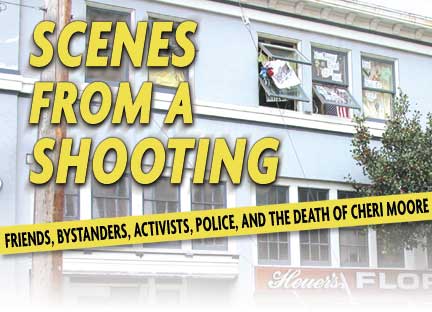
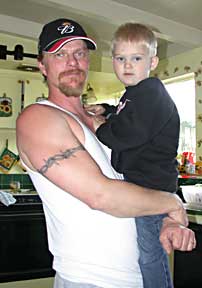 On that Friday morning,
Marcus Smith (left), a jack-of-all-trades with his own
small business, was headed up Fifth Street, toward Arcata, for
a job. He was in his van, with a co-worker. Passing G Street,
he happened to turn his head. He saw a police officer carrying
what looked to him like a machine gun. The cop was just outside
his friend Cheri's apartment. He turned around and headed back
to the scene.
On that Friday morning,
Marcus Smith (left), a jack-of-all-trades with his own
small business, was headed up Fifth Street, toward Arcata, for
a job. He was in his van, with a co-worker. Passing G Street,
he happened to turn his head. He saw a police officer carrying
what looked to him like a machine gun. The cop was just outside
his friend Cheri's apartment. He turned around and headed back
to the scene.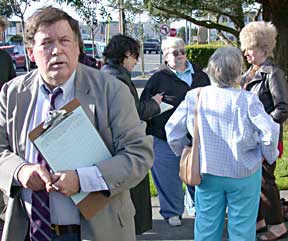 On
the Tuesday after Moore was killed, a vigil for her was held
outside Eureka City Hall, right before the City Council was to
meet. The vigil was well attended, and drew many different types
of people: people who had met Moore in her peregrinations around
Eureka, people suffering from mental illness and their caregivers
and political activists. Richard Salzman, who used to head District
Attorney Paul Gallegos' political reelection committee before
being caught writing letters to the editor under phony names,
and who is actively campaigning for Gallegos in the run-up to
the June election, arrived at the vigil early and thanked people
for coming. For some, Gallegos' indifferent relationship with
law enforcement -- he has said that he will not seek the endorsement
of police associations, and they are not inclined to give it
to him -- is the only hope that the investigation into Moore's
shooting will be thorough and fair.
On
the Tuesday after Moore was killed, a vigil for her was held
outside Eureka City Hall, right before the City Council was to
meet. The vigil was well attended, and drew many different types
of people: people who had met Moore in her peregrinations around
Eureka, people suffering from mental illness and their caregivers
and political activists. Richard Salzman, who used to head District
Attorney Paul Gallegos' political reelection committee before
being caught writing letters to the editor under phony names,
and who is actively campaigning for Gallegos in the run-up to
the June election, arrived at the vigil early and thanked people
for coming. For some, Gallegos' indifferent relationship with
law enforcement -- he has said that he will not seek the endorsement
of police associations, and they are not inclined to give it
to him -- is the only hope that the investigation into Moore's
shooting will be thorough and fair.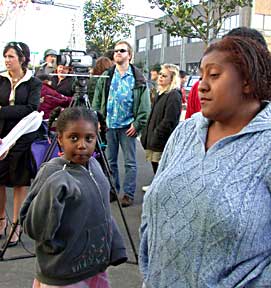 "I never would
have guessed that there was anything wrong with her," said
Gidget Leavell, who works with Khan at Duck's and attended the
vigil with Khan. "She was so polite." Leavell said
she was shocked and shaken when she saw Moore's picture in the
newspaper the day after the shooting, wearing her neck brace
and poking her head out the window for a moment.
"I never would
have guessed that there was anything wrong with her," said
Gidget Leavell, who works with Khan at Duck's and attended the
vigil with Khan. "She was so polite." Leavell said
she was shocked and shaken when she saw Moore's picture in the
newspaper the day after the shooting, wearing her neck brace
and poking her head out the window for a moment.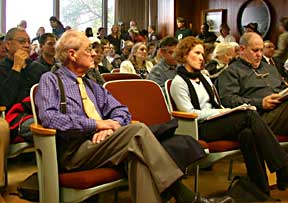 Allen
told the council that the issue was coming, that Eureka voters
would support it, and that it couldn't be more timely. While
many people were waiting for the official investigation into
the shooting to conclude, he said, very few would place any great
stock in its conclusions.
Allen
told the council that the issue was coming, that Eureka voters
would support it, and that it couldn't be more timely. While
many people were waiting for the official investigation into
the shooting to conclude, he said, very few would place any great
stock in its conclusions.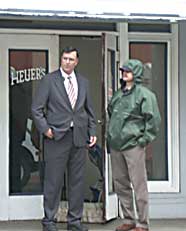 Near
the entrance to the building, EPD Chief Dave Douglas walked back
and forth, talking briefly to his officers. District Attorney
Paul Gallegos arrived and spoke to someone on the ground, gesturing
with his hands, evidently in an attempt to clarify a point. Eventually,
two grief-stricken young women arrived and were ushered upstairs.
Near
the entrance to the building, EPD Chief Dave Douglas walked back
and forth, talking briefly to his officers. District Attorney
Paul Gallegos arrived and spoke to someone on the ground, gesturing
with his hands, evidently in an attempt to clarify a point. Eventually,
two grief-stricken young women arrived and were ushered upstairs.